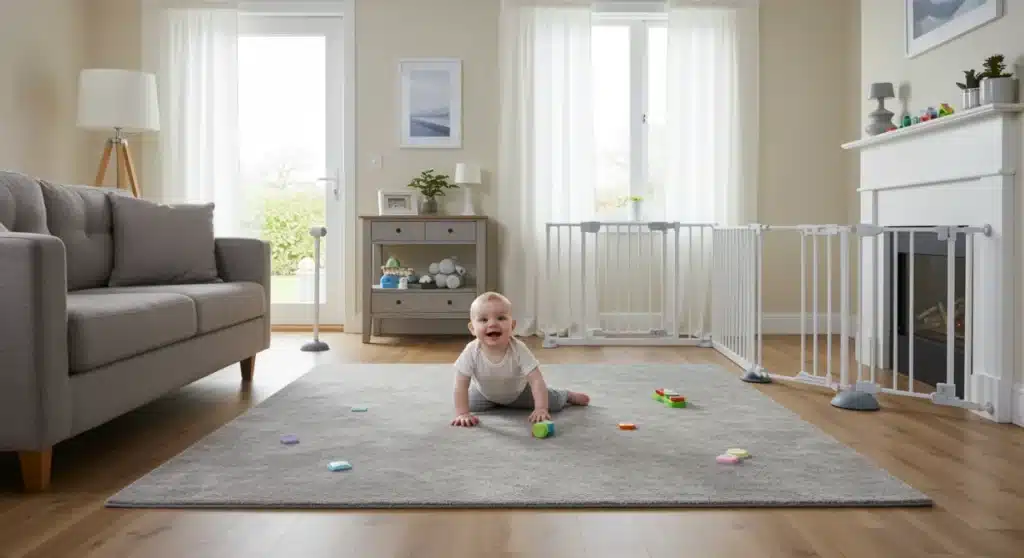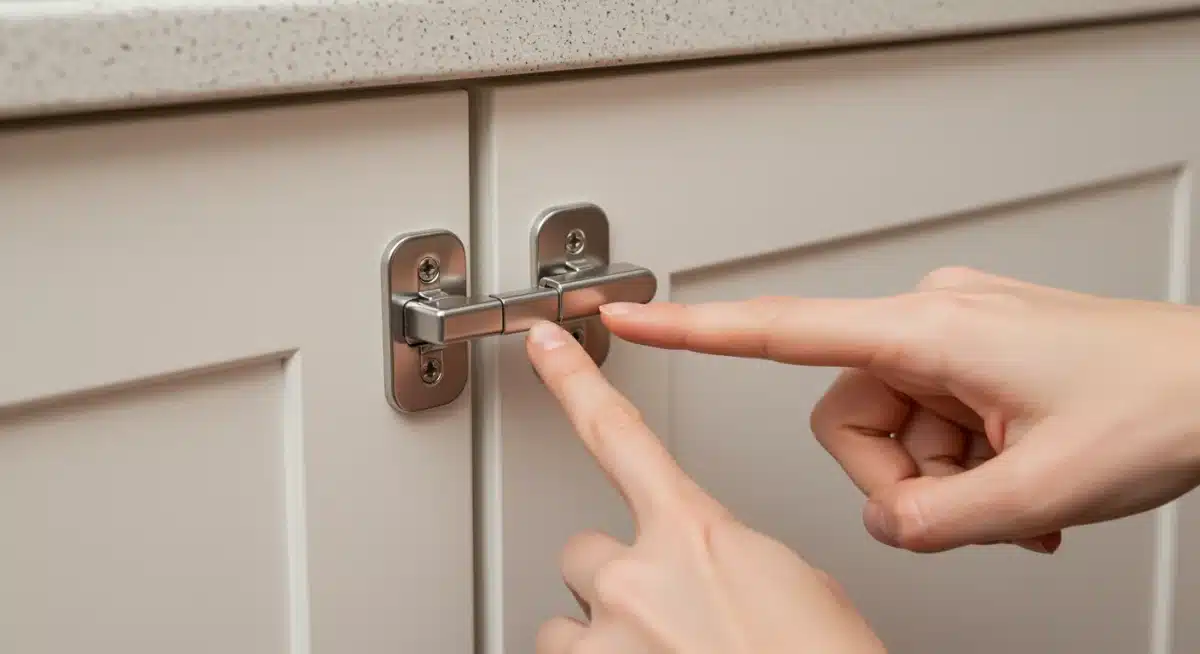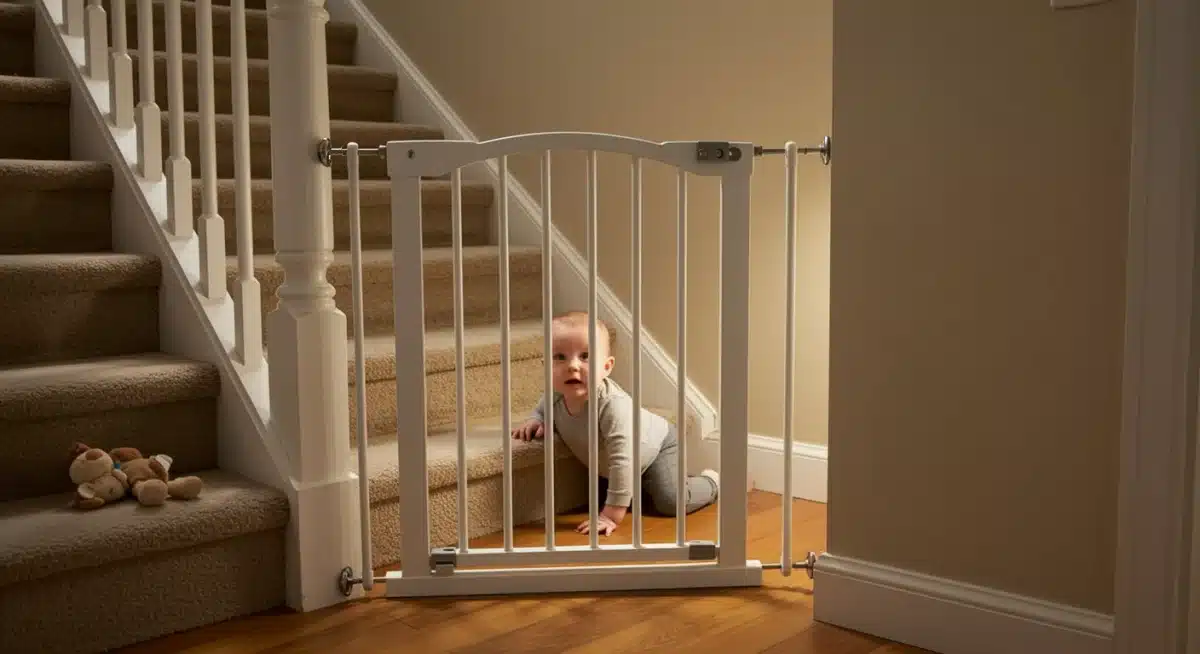Babyproofing Your Home: Ultimate Safety Guide for Parents

Advertisement
Creating a safe home environment for your baby is paramount, and effective babyproofing involves systematically identifying and mitigating potential hazards throughout your living space, ensuring peace of mind for parents and caregivers.
As expectant parents, or those with a new arrival, the world suddenly takes on a new perspective. Every sharp corner, every accessible outlet, and every unsecured cabinet transforms into a potential hazard. This is where babyproofing home safety becomes not just a task, but a vital step in preparing for your little one’s exploratory journey through life. Ensuring your home is a sanctuary where your child can grow and discover safely is a top priority for any parent.
Understanding the Babyproofing Mindset
Babyproofing isn’t merely about buying a few safety gadgets; it’s about adopting a new way of seeing your home through the eyes of a curious, developing child. This involves getting down on your hands and knees to spot potential dangers that might not be obvious from an adult’s perspective. It’s an ongoing process that evolves as your child grows and reaches new developmental milestones.
Advertisement
Thinking like a baby means anticipating their movements, their reach, and their innate desire to touch, taste, and explore everything. From crawling to walking, each stage brings new challenges and requires different safety measures. A proactive approach is always better than a reactive one when it comes to child safety.
The Importance of Early Assessment
Starting early with babyproofing allows you to tackle the task systematically and reduce stress. It’s often recommended to begin before your baby becomes mobile, giving you ample time to implement necessary changes without the added pressure of a crawling or walking toddler.
- Crawling Stage: Focus on floor-level hazards, outlets, and cabinet contents.
- Walking Stage: Elevate your concern to furniture stability, stair safety, and accessible windows.
- Toddler Stage: Consider child-resistant locks for doors, appliance safety, and choking hazards.
Ultimately, understanding the babyproofing mindset means being vigilant, patient, and prepared to adapt your home as your child grows. It’s about creating a nurturing environment where exploration is encouraged within safe boundaries, fostering independence and learning without unnecessary risks.
Advertisement
Securing Electrical Outlets and Cords
One of the most common and easily overlooked hazards in any home is electrical outlets and cords. Babies are naturally drawn to small holes and dangling objects, making these a prime target for their curious hands. Addressing these dangers is a fundamental step in comprehensive babyproofing, protecting your child from shocks and other electrical injuries.
There are various solutions available, each offering different levels of protection and ease of use for parents. The key is to choose products that are durable, effective, and difficult for a child to remove or bypass.
Choosing the Right Outlet Covers
Not all outlet covers are created equal. Basic plastic plugs can be easily removed by determined toddlers, posing a new choking hazard. Spring-loaded or sliding covers are generally more secure and are often a better long-term solution.
- Sliding Outlet Covers: These covers require an adult to slide them to access the outlet, automatically returning to the closed position when not in use.
- Box Covers: For frequently used outlets, box covers enclose the entire outlet and plug, making it impossible for children to access.
- Self-Closing Outlets: These modern outlets have built-in shutters that automatically cover the slots when a plug is removed.
Beyond the outlets themselves, managing electrical cords is equally important. Dangling cords can be a strangulation risk or tripped over. Secure them with cord shorteners, ties, or conceal them within furniture or wall-mounted channels. Ensure no cords run under rugs, as this can cause overheating or become a fire hazard. By systematically addressing these electrical concerns, you significantly reduce the risk of accidents in your home, providing a safer space for your baby to explore.
Furniture and Appliance Anchoring
As babies grow and become more mobile, they often use furniture to pull themselves up, leading to a significant risk of tip-overs. Dressers, bookshelves, and televisions can pose a serious danger if not properly secured. Anchoring these items is a critical component of effective babyproofing, preventing tragic accidents.
The weight and stability of an item can be deceptive; even seemingly heavy furniture can be pulled over by a curious child. It’s essential to assess every room for potential tip-over hazards and take proactive measures.

Selecting the Correct Anchoring Hardware
Various types of anchoring kits are available, designed for different furniture types and wall materials. Always choose a kit that is appropriate for your specific furniture and wall construction to ensure maximum security.
- Anti-Tip Straps: These straps attach to the back of furniture and are then screwed into a wall stud.
- L-Brackets: Metal L-brackets can be used to secure furniture to the wall, offering a strong hold.
- Adhesive Anchors: While less robust, adhesive anchors can be used for lighter items or in situations where drilling is not an option, but always test their strength.
Appliances such as stoves, refrigerators, and dishwashers also require attention. Child-resistant locks for appliance doors prevent little hands from opening them and accessing potentially dangerous contents or hot surfaces. Additionally, securing the anti-tip bracket that often comes with ranges is crucial to prevent them from tipping if a child stands on the open oven door. Remember to also secure flat-screen TVs with safety straps, even if they are on a stand, as they can easily fall if bumped or pulled. Thoroughly anchoring furniture and appliances provides a robust layer of protection, allowing your child to navigate their environment without the constant threat of tip-over incidents.
Kitchen and Bathroom Safety Measures
The kitchen and bathroom are two of the most hazardous rooms in a home for a baby, filled with sharp objects, chemicals, hot water, and slippery surfaces. Implementing specific safety measures in these areas is non-negotiable for comprehensive babyproofing. A detailed approach is required to mitigate the unique risks each room presents.
From cleaning supplies to medications, and from hot stoves to slippery tubs, these rooms demand constant vigilance and robust safety solutions. It’s important to never underestimate a child’s ability to reach or open things.
Securing Cabinets and Drawers
Childproof locks for cabinets and drawers are essential to prevent access to cleaning products, sharp utensils, and medications. There are several types of locks, each with its own advantages.
- Magnetic Locks: These are installed inside cabinets and drawers, completely hidden from view, and require a magnetic key to open.
- Spring Release Latches: Installed inside, these require an adult to push down on a spring mechanism to open the cabinet.
- External Latches: Visible latches that wrap around handles or knobs, often used for temporary solutions or on less frequently accessed cabinets.
In the kitchen, remember to use stove knob covers to prevent accidental activation and consider oven locks. Keep all small appliances, like toasters and blenders, out of reach. In the bathroom, always keep toilet lids locked to prevent drowning hazards and ensure all medications, toiletries, and cleaning supplies are stored in high, locked cabinets. Non-slip mats in the tub and on the bathroom floor can prevent falls. Additionally, set your water heater thermostat to no higher than 120°F (49°C) to prevent scalding. By diligently applying these kitchen and bathroom safety measures, you create a much safer environment, transforming these high-risk areas into spaces where accidents are significantly less likely.
Stairways, Windows, and Doors
Stairways, windows, and doors present distinct safety challenges that require specific babyproofing strategies. Unprotected stairs can lead to serious falls, open windows pose a risk of falls, and unsecured doors can lead to unsupervised wandering. Addressing these structural elements is crucial for your child’s safety.
As your baby becomes more mobile, their curiosity will lead them to explore every nook and cranny, including these potential danger zones. Planning ahead for these areas is vital to prevent accidents.
Installing Safety Gates
Safety gates are indispensable for preventing access to stairways and restricting movement between rooms. They come in various types, each suited for different needs.
- Hardware-Mounted Gates: These gates are screwed into the wall and are ideal for the top of staircases, offering maximum security.
- Pressure-Mounted Gates: These gates are held in place by pressure and are suitable for doorways between rooms, but should NEVER be used at the top of stairs.
- Retractable Gates: These gates retract when not in use, making them less obtrusive for high-traffic areas.
Window safety is another critical aspect. Install window guards or stops that prevent windows from opening more than a few inches, but ensure they can be easily removed by an adult in case of an emergency. Keep all cords from blinds and curtains tied up and out of reach to prevent strangulation. For doors, consider childproof doorknob covers or lever handle locks to prevent your child from opening exterior doors or accessing off-limit rooms. Always be mindful of pinch points in doors and use door stoppers or finger guards to prevent little fingers from getting caught. By carefully managing stairways, windows, and doors, you build a protective perimeter around your child, giving them the freedom to explore within defined safe zones.

Choking Hazards and Toy Safety
One of the most insidious dangers for babies and young children is choking, often caused by small objects that can easily fit into their mouths. Identifying and eliminating potential choking hazards is an ongoing process that requires constant vigilance, as new items can always find their way into a child’s reach. Toy safety is also paramount, as not all toys are appropriate for all ages.
It’s important to regularly inspect toys and the general environment for anything that could pose a choking risk. The ‘choke tube’ test, where an object that fits entirely into a toilet paper roll is considered a choking hazard for children under three, is a useful guideline.
Identifying and Eliminating Small Objects
Many everyday household items can be choking hazards. A thorough sweep of your home should be conducted regularly, especially in areas where your child plays.
- Small Toys and Parts: Ensure all toys are age-appropriate and do not have detachable small parts.
- Food Items: Cut grapes, hot dogs, and other round foods into small, manageable pieces.
- Household Items: Coins, buttons, batteries, and small magnets are common culprits.
Beyond small objects, toy safety extends to the condition and construction of the toys themselves. Regularly check toys for broken pieces, sharp edges, or loose parts that could become choking hazards. Ensure battery compartments are securely fastened and require a tool to open. Avoid toys with long strings or cords, which can pose a strangulation risk. When purchasing new toys, always check the age recommendations and safety certifications. By being diligent about identifying and eliminating choking hazards and ensuring toy safety, you create a much safer play environment, allowing your child to engage with their surroundings without the constant threat of accidental ingestion or injury.
Emergency Preparedness and Ongoing Vigilance
Even the most meticulously babyproofed home can’t eliminate all risks. Therefore, emergency preparedness and ongoing vigilance are crucial components of a comprehensive safety plan. Knowing what to do in an emergency and continuously monitoring your home for new hazards ensures a proactive approach to your child’s well-being.
Babyproofing is not a one-time task; it’s an evolving responsibility that adapts as your child grows and develops new skills. What was safe yesterday might not be safe tomorrow.
Creating an Emergency Plan
Having a clear emergency plan can make all the difference in a crisis. This includes knowing basic first aid and CPR, and having important contact numbers readily available.
- First Aid and CPR: Enroll in a certified infant and child first aid and CPR course.
- Emergency Contacts: Post emergency numbers (poison control, pediatrician, emergency services) in a visible place.
- First Aid Kit: Keep a well-stocked first aid kit easily accessible, but out of reach of children.
Ongoing vigilance means regularly reassessing your home for new hazards. As your child learns to climb, open doors, or reach higher, new areas may become accessible to them. Periodically re-evaluate your babyproofing measures, especially after significant developmental milestones. Engage other caregivers, like grandparents or babysitters, in understanding your home’s safety protocols. Discuss potential hazards and how to use safety devices correctly. By combining thorough babyproofing with a robust emergency plan and continuous vigilance, you create the safest possible environment for your child, giving you peace of mind and allowing your little one to thrive and explore securely.
| Key Area | Safety Measure |
|---|---|
| Outlets & Cords | Install sliding outlet covers and secure dangling cords to prevent shocks and strangulation. |
| Furniture Stability | Anchor heavy furniture like dressers and TVs to walls to prevent tip-overs. |
| Kitchen/Bathroom | Use childproof locks on cabinets, secure toilet lids, and store chemicals out of reach. |
| Stairs & Windows | Install safety gates at stairs and window guards to prevent falls. |
Frequently Asked Questions About Babyproofing
It’s ideal to start babyproofing before your baby becomes mobile, typically around 4-6 months of age. This gives you ample time to identify and address potential hazards before your little one is actively exploring the environment, ensuring a safe space from the moment they start crawling.
Common mistakes include underestimating a child’s curiosity, only babyproofing at floor level, neglecting to secure heavy furniture, and using pressure-mounted gates at the top of stairs. It’s crucial to think like a crawling baby and continuously reassess your home’s safety as your child grows.
No, not all safety gates are equally effective or suitable for every location. Hardware-mounted gates are best for the top of stairs due to their secure installation, while pressure-mounted gates are only recommended for doorways between rooms where there’s no fall hazard.
Any object small enough to fit entirely inside a toilet paper roll is generally considered a choking hazard for children under three. Regularly check toys, household items like coins and batteries, and even certain foods, ensuring everything within reach is larger than this guideline.
While some rooms like the kitchen and bathroom require more intensive measures, it’s advisable to babyproof your entire home. Babies are quick explorers, and even areas you deem safe can harbor hidden dangers. A comprehensive approach ensures consistent safety throughout your living space.
Conclusion
Creating a safe and nurturing environment for your little one is an ongoing journey that begins with thoughtful and thorough babyproofing. From securing electrical outlets and anchoring furniture to safeguarding kitchens and bathrooms, every step taken contributes to a home where your child can explore, learn, and grow without unnecessary risks. Remember, babyproofing is not a one-time task but a continuous process that evolves with your child’s developmental stages. By combining practical safety measures with ongoing vigilance and emergency preparedness, you can cultivate a sanctuary where peace of mind flourishes, allowing both parents and children to fully embrace the joys of early childhood.





